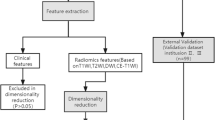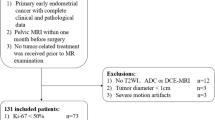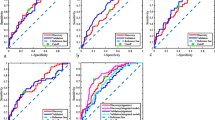Abstract
Purpose
To evaluate the performance of multisequence magnetic resonance imaging (MRI)-based radiomics models in the assessment of microsatellite instability (MSI) status in endometrial cancer (EC).
Materials and methods
This retrospective multicentre study included 338 EC patients with available MSI status and preoperative MRI scans, divided into training (37 MSI, 123 microsatellite stability [MSS]), internal validation (15 MSI, 52 MSS), and external validation cohorts (30 MSI, 81 MSS). Radiomics features were extracted from T2-weighted images, diffusion-weighted images, and contrast-enhanced T1-weighted images. The ComBat harmonisation method was applied to remove intrascanner variability. The Boruta wrapper algorithm was used for key feature selection. Three classification algorithms, logistic regression (LR), random forest (RF), and support vector machine (SVM), were applied to build the radiomics models. The area under the receiver operating characteristic curve (AUC) was calculated to compare the diagnostic performance of the models. Decision curve analysis (DCA) was conducted to determine the clinical usefulness of the models.
Results
Among the 1980 features, Boruta finally selected nine radiomics features. A higher MSI prediction performance was achieved after running the ComBat harmonisation method. The SVM algorithm had the best performance, with AUCs of 0.921, 0.903, and 0.937 in the training, internal validation, and external validation cohorts, respectively. The DCA results showed that the SVM algorithm achieved higher net benefits than the other classifiers over a threshold range of 0.581–0.783.
Conclusion
The multisequence MRI-based radiomics models showed promise in preoperatively predicting the MSI status in EC in this multicentre setting.





Similar content being viewed by others
Abbreviations
- EC:
-
Endometrial cancer
- MSI:
-
Microsatellite instability
- MSS:
-
Microsatellite stability
- MMR:
-
Mismatch repair
- LR:
-
Logistic regression
- RF:
-
Random forest
- SVM:
-
Support vector machine
- DCA:
-
Decision curve analysis
- AUC:
-
Area under the receiver operating characteristic curve
- ROI:
-
Region of interest
- ICC:
-
Intraclass correlation coefficient
References
Lu KH, Broaddus RR (2020) Endometrial cancer. N Engl J Med 383:2053–2064
Bell DW, Ellenson LH (2019) Molecular genetics of endometrial carcinoma. Annu Rev Pathol 14:339–367
Hamilton CA, Pothuri B, Arend RC et al (2021) Endometrial cancer: a society of gynecologic oncology evidence-based review and recommendations. Gynecol Oncol 160:817–826
Latham A, Srinivasan P, Kemel Y et al (2019) Microsatellite instability is associated with the presence of lynch syndrome pan-cancer. J Clin Oncol 37:286–295
Xiao JP, Wang JS, Zhao YY, Du J, Wang YZ (2022) Microsatellite instability as a marker of prognosis: a systematic review and meta-analysis of endometrioid endometrial cancer survival data. Arch Gynecol Obstet. https://doi.org/10.1007/s00404-022-06636-8
Evrard C, Alexandre J (2021) Predictive and prognostic value of microsatellite instability in gynecologic cancer (endometrial and ovarian). Cancers Basel 13(10):2434
Lu C, Guan J, Lu S et al (2021) DNA sensing in mismatch repair-deficient tumor cells is essential for anti-tumor immunity. Cancer Cell 39:96-108.e106
O’Malley DM, Bariani GM, Cassier PA et al (2022) Pembrolizumab in patients with microsatellite instability-high advanced endometrial cancer: results from the KEYNOTE-158 study. J Clin Oncol 40:752–761
Makker V, Colombo N, Casado Herráez A et al (2022) Lenvatinib plus Pembrolizumab for advanced endometrial cancer. N Engl J Med 386:437–448
Abu-Rustum NR, Yashar CM, Bradley K et al (2021) NCCN Guidelines® insights: uterine neoplasms, version 3.2021. J Natl Compr Canc Netw 19:888–895
Concin N, Matias-Guiu X, Vergote I et al (2021) ESGO/ESTRO/ESP guidelines for the management of patients with endometrial carcinoma. Int J Gynecol Cancer 31:12–39
Visser NCM, Reijnen C, Massuger L, Nagtegaal ID, Bulten J, Pijnenborg JMA (2017) Accuracy of endometrial sampling in endometrial carcinoma: A systematic review and meta-analysis. Obstet Gynecol 130:803–813
Veeraraghavan H, Friedman CF, DeLair DF et al (2020) Machine learning-based prediction of microsatellite instability and high tumor mutation burden from contrast-enhanced computed tomography in endometrial cancers. Sci Rep 10:17769
Mayerhoefer ME, Materka A, Langs G et al (2020) Introduction to Radiomics. J Nucl Med 61:488–495
Lambin P, Leijenaar RTH, Deist TM et al (2017) Radiomics: the bridge between medical imaging and personalized medicine. Nat Rev Clin Oncol 14:749–762
Ueno Y, Forghani B, Forghani R et al (2017) Endometrial carcinoma: MR imaging-based texture model for preoperative risk stratification—a preliminary analysis. Radiology 284:748–757
Luo Y, Mei D, Gong J, Zuo M, Guo X (2020) Multiparametric MRI-based radiomics nomogram for predicting lymphovascular space invasion in endometrial carcinoma. J Magn Reson Imaging 52:1257–1262
Yan BC, Li Y, Ma FH et al (2021) Radiologists with MRI-based radiomics aids to predict the pelvic lymph node metastasis in endometrial cancer: a multicenter study. Eur Radiol 31:411–422
De Smedt L, Lemahieu J, Palmans S et al (2015) Microsatellite instable vs stable colon carcinomas: analysis of tumour heterogeneity, inflammation and angiogenesis. Br J Cancer 113:500–509
Zhang W, Huang Z, Zhao J et al (2021) Development and validation of magnetic resonance imaging-based radiomics models for preoperative prediction of microsatellite instability in rectal cancer. Ann Transl Med 9:134
Li Z, Dai H, Liu Y, Pan F, Yang Y, Zhang M (2021) Radiomics analysis of multi-sequence MR images for predicting microsatellite instability status preoperatively in rectal cancer. Front Oncol 11:697497
Stelloo E, Jansen AML, Osse EM et al (2017) Practical guidance for mismatch repair-deficiency testing in endometrial cancer. Ann Oncol 28:96–102
Luchini C, Bibeau F, Ligtenberg MJL et al (2019) ESMO recommendations on microsatellite instability testing for immunotherapy in cancer, and its relationship with PD-1/PD-L1 expression and tumour mutational burden: a systematic review-based approach. Ann Oncol 30:1232–1243
van Griethuysen JJM, Fedorov A, Parmar C et al (2017) Computational radiomics system to decode the radiographic phenotype. Cancer Res 77:e104–e107
Mali SA, Ibrahim A, Woodruff HC et al (2021) Making radiomics more reproducible across scanner and imaging protocol variations: A review of harmonization methods. J Pers Med 11:842
Orlhac F, Lecler A, Savatovski J et al (2021) How can we combat multicenter variability in MR radiomics? Validation of a correction procedure. Eur Radiol 31:2272–2280
Da-Ano R, Masson I, Lucia F et al (2020) Performance comparison of modified ComBat for harmonization of radiomic features for multicenter studies. Sci Rep 10:10248
Wadee R, Grayson W (2019) A potpourri of pathogenetic pathways in endometrial carcinoma with a focus on Lynch syndrome. Ann Diagn Pathol 39:92–104
Ren J, Yuan Y, Qi M, Tao X (2020) Machine learning-based CT texture analysis to predict HPV status in oropharyngeal squamous cell carcinoma: comparison of 2D and 3D segmentation. Eur Radiol 30:6858–6866
Shen C, Liu Z, Guan M et al (2017) 2D and 3D CT radiomics features prognostic performance comparison in non-small cell lung cancer. Transl Oncol 10:886–894
Li ZC, Bai H, Sun Q et al (2018) Multiregional radiomics features from multiparametric MRI for prediction of MGMT methylation status in glioblastoma multiforme: a multicentre study. Eur Radiol 28:3640–3650
Abbasian Ardakani A, Bureau NJ, Ciaccio EJ, Acharya UR (2021) Interpretation of radiomics features—a pictorial review. Comput Methods Programs Biomed 215:106609
Tian Q, Yan LF, Zhang X et al (2018) Radiomics strategy for glioma grading using texture features from multiparametric MRI. J Magn Reson Imaging 48:1518–1528
Daye D, Tabari A, Kim H et al (2021) Quantitative tumor heterogeneity MRI profiling improves machine learning-based prognostication in patients with metastatic colon cancer. Eur Radiol 31:5759–5767
Huang S, Cai N, Pacheco PP, Narrandes S, Wang Y, Xu W (2018) Applications of support vector machine (SVM) learning in cancer genomics. Cancer Genomics Proteomics 15:41–51
Noble WS (2006) What is a support vector machine? Nat Biotechnol 24:1565–1567
Wang X, Wan Q, Chen H, Li Y, Li X (2020) Classification of pulmonary lesion based on multiparametric MRI: utility of radiomics and comparison of machine learning methods. Eur Radiol 30:4595–4605
Qian Z, Li Y, Wang Y et al (2019) Differentiation of glioblastoma from solitary brain metastases using radiomic machine-learning classifiers. Cancer Lett 451:128–135
Yin P, Mao N, Zhao C et al (2019) Comparison of radiomics machine-learning classifiers and feature selection for differentiation of sacral chordoma and sacral giant cell tumour based on 3D computed tomography features. Eur Radiol 29:1841–1847
Mao B, Ma J, Duan S, Xia Y, Tao Y, Zhang L (2021) Preoperative classification of primary and metastatic liver cancer via machine learning-based ultrasound radiomics. Eur Radiol 31:4576–4586
Funding
The authors declare that no funds, grants, or other support were received during the preparation of this manuscript.
Author information
Authors and Affiliations
Contributions
All authors contributed to the study conception and design. Material preparation, data collection and analysis were performed by XLS, HJL, JLR, PY, YL, JLN and NH. The first draft of the manuscript was written by XLS, HJL and JLR. The manuscript was revised by NH, JLN, XLS, HJL and JLR. And all authors commented on previous versions of the manuscript. All authors read and approved the final manuscript.
Corresponding author
Ethics declarations
Conflict of interest
The authors declare that they have no conflict of interest.
Ethical standards and Informed consent.
This study was approved by the local ethic committee and written informed consent was waived due to the retrospective nature of the study.
Additional information
Publisher's Note
Springer Nature remains neutral with regard to jurisdictional claims in published maps and institutional affiliations.
Supplementary Information
Below is the link to the electronic supplementary material.
Rights and permissions
Springer Nature or its licensor (e.g. a society or other partner) holds exclusive rights to this article under a publishing agreement with the author(s) or other rightsholder(s); author self-archiving of the accepted manuscript version of this article is solely governed by the terms of such publishing agreement and applicable law.
About this article
Cite this article
Song, XL., Luo, HJ., Ren, JL. et al. Multisequence magnetic resonance imaging-based radiomics models for the prediction of microsatellite instability in endometrial cancer. Radiol med 128, 242–251 (2023). https://doi.org/10.1007/s11547-023-01590-0
Received:
Accepted:
Published:
Issue Date:
DOI: https://doi.org/10.1007/s11547-023-01590-0




